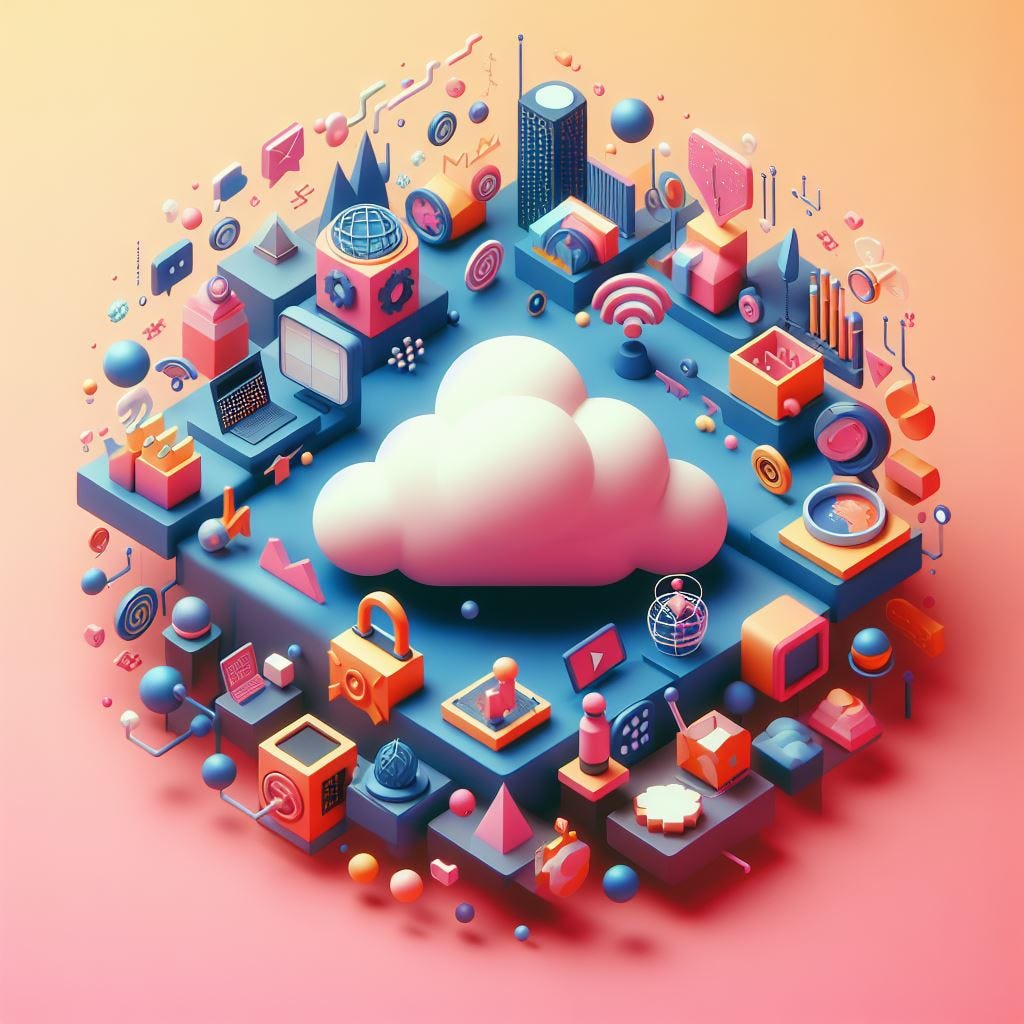Global hi-tech trends in 2024
What are the most trending and perspective fields in hi-tech industry in 2024?
100 years ago, the biggest innovation was the development of the first automatic transmission by General Motors. Today, we have autonomous cars that can travel without human input. Of course, we imagined the 21st century in a more futuristic light, but this is just the beginning!
Deals of 2023
The mega-deal of the year was Microsoft's $68.7 billion acquisition of Activision Blizzard, which reshaped the gaming landscape.
OpenAI was valued at $100 billion, making it a beacon of excitement in the field of generative intelligence.
Sustainable tech, taking center stage, got over $541.6 billion in investments for renewable energy, green AI, and carbon capture solutions.
2023 was a year of technological leaps and bounds, fueled by record-breaking investments and a thirst for innovation.

Microsoft and Google continue to compete for supremacy in the quantum computing race, having made significant technological breakthroughs. Elon Musk’s Neuralink has achieved human trial approval, and no one knows how it will revolutionize human-machine interaction. Silicon Valley Bank’s collapse disrupted the tech funding landscape, sending shockwaves through the tech industry.
In fact, 2023 was too turbulent to remember all the major events. It is even harder to predict where the tech sector is heading in 2024 and beyond. Without romanticizing the future or being too pessimistic, let’s simply list the top five tech segments and innovations within the segments.
Generative AI
This would be inconsistent if we started the list with something other than generative AI. Beyond chatbots and text generation, generative AI immediately changed game rules, revolutionizing design, content creation, and even drug discovery.
Key trends in generative AI
75% of generative AI is shared between customer operations, software engineering, and marketing. The numbers will change rapidly due to the expansion of AI in other segments.
In customer service, generative AI will handle most operations, offering instant and accurate responses, customer data gathering and analysis, personalized recommendations, etc.
In marketing, AI solutions will enable hyper-quick marketing content creation, automate repetitive tasks, provide extensive data analysis for data-driven decision-making, omnichannel strategy optimization, etc.
In software engineering, generative AI will streamline requirement gathering, UI template creation, code snippet generation, and crafting test cases.
The expansion of AI will be driven by the increasing demand for personalized content, automation, and scientific breakthroughs.
Figures and statistics
The global generative AI market is expected to reach $66.62 billion by 2024, growing at a CAGR of 20.80%.
65% of generative AI users are Gen Z and Millennials.
2.3 billion images were generated by Dall-E2 within its first two months of public beta.
Biggest deals of 2023
OpenAI: Creators of Dall-E 2, a leading text-to-image generative AI platform, attracted over $1 billion in funding, including a $100 billion valuation in 2023.
RunwayML: The company, which is developing AI tools for fashion design and generation, secured $4.3 million in seed funding in 2023 and already has partnerships with major fashion brands.
Anthropic: Develops advanced language models and aims to build safe and reliable AI. It raised $750 million in an ongoing funding round in 2024, and its valuation estimates range from $15 billion to $30 billion.
Inflection AI: Building the "largest AI cluster in the world" to develop powerful AI assistants. The company secured $1.3 billion in funding in 2023, led by Microsoft and prominent investors, and has partnerships with companies like Nvidia.
The future of generative AI
Generative AI will get bigger and more serious, making a huge impact on enterprises.
By 2026, 100 million humans will interact with robo-colleagues.
By 2028, there will be more AI-powered tools than frontline workers in retail, logistics, and manufacturing, cutting labor shortages.
By 2027, 15% of applications will be AI-generated without any human intervention.
Cybersecurity
The expansion of digital infrastructure has led to an increase in cyberattacks. The demand for robust cybersecurity solutions and cybersecurity startups attracted $16.7 billion in funding, reflecting the urgency of dealing with increasing threats.
Figures and statistics
The global cybersecurity market is estimated to reach $183.10 billion by 2024, growing at a CAGR of 10.56%.
98% of organizations experienced a cyberattack in 2023, resulting in a cost of $4.45 million due to data breaches.
AI-powered cybersecurity solutions saw a 36% increase in investment in 2023.
Big players
Crowdstrike: Leading endpoint security provider, boasting over $4.7 billion in annual revenue.
Palo Alto Networks: This networking giant has a strong emphasis on cloud security, with annual revenue surpassing $5 billion.
Cisco: The company offers comprehensive security solutions across network infrastructure, endpoints, and the cloud, with annual security revenue exceeding $8 billion.
The future of cybersecurity
The rise of AI and machine learning will play a crucial role in defense (and offense as well). Advanced threat detection will enable the identification and mitigation of sophisticated attacks, while attackers will use the same AI to automate tactics. This battle will only intensify as machines get smarter.
Modern cloud applications, IoT, and remote workforces will force companies to think of replacing traditional perimeter defenses with zero-trust security, cloud-native security, or endpoint security.
Quantum Computing
No longer science fiction, quantum computing is entering its practical phase. Mere mortals, just like us, don’t know much about quantum computing; the industry already holds immense promise for materials science, drug discovery, and financial modeling. Early adopters promise to reshape entire industries.
Figures and statistics
The global quantum computing market is projected to reach $6.5 billion by 2033, growing at a CAGR of 23.5%.
D-Wave's quantum computers operate at -460°F, just 0.02 degrees above absolute zero! That's colder than the surface of Pluto!
Google Quantum AI leads the field with hardware like Sycamore and software platforms like Cirq, and it partners with companies like BMW and Pfizer.
Industry leaders
IONQ: Boasts a $4 billion market capitalization after entering the public arena as the first pure-play quantum computing company.
Tech giants: Names like Microsoft, Alphabet (owner of Google), Nvidia, and Intel are actively involved in the industry, with market capitalizations exceeding $1 trillion for Microsoft and Alphabet and significantly over $100 billion for Nvidia and Intel.
Established players: Legacy tech companies like Honeywell and IBM, with market capitalizations of $124 billion and $135 billion, respectively, are also making significant investments in quantum computing.
The future of quantum computing
In the future, quantum computing will evolve from a theoretical playground to a practical tool actively changing healthcare, fintech, and materials science.
Cloud-based access to quantum computers will democratize the technology, making its power accessible to startups and researchers.
Metaverse
While the metaverse's full potential remains undefined, its allure is undeniable. Step by step, it changes experiences in a digital environment with its virtual social spaces, like Decentraland, to augmented reality experiences.
Figures and statistics
The global metaverse market is projected to reach $507.8 billion by 2030, with an expected 2.66 million users.
In 2023, metaverse startups raised over $13 billion in funding, highlighting investor confidence.
Decentraland and Sandbox platforms are seeing surging user engagement, showcasing demand for immersive social experiences.
Industry players
Meta (formerly Facebook): Leading VR hardware creator with Oculus Quest, investing heavily in Metaverse infrastructure and social platform Horizon Worlds.
Microsoft: Developing Mesh for presence and shared reality experiences available from anywhere.
Decentraland: Established virtual world platform with a huge user base and decentralized economy working on NFTs.
The future of Metaverse
By 2030, many people may spend more time in the metaverse than in reality. Good or bad, people will exploit virtual capabilities more for work, education, and entertainment.
Being not so valuable for daily life, Metaverse’s implementation will be limited to a certain group of people.
Gaming and e-commerce will be the most affected segments, offering new experiences in the metaverse.
Sustainable tech
Sustainable economy, sustainable fashion, sustainable consumers. What’s next? Sustainable technology encompasses solutions like renewable energy, green AI, the circular economy, green transportation, and smart agriculture.
Figures and statistics
The global green tech market will reach $44.55 billion by 2028, signifying a massive growth trajectory.
With the increasing popularity of online data centers, companies are willingly replacing their energy-sucking data centers and physical storage systems with cloud technology.
Solar energy installations continue to surge, with the International Energy Agency forecasting 10% annual growth over the next five years.
Industry players
Tesla leads the electric vehicle revolution, inspiring other brands to develop electric models. At the same time, companies like First Solar and Vestas dominate the solar energy industry.
AI giants like Google and Microsoft are developing green AI initiatives, and startups like Nauto use AI to optimize traffic flow and reduce emissions.
Names like Beyond Meat and Impossible Foods are pioneering plant-based protein alternatives, disrupting the traditional meat industry.
The future of sustainable tech
Renewable energy will be on the rise with advancements in battery technology and energy storage.
The integration of AI and the Internet of Things (IoT) will create smart ecosystems and optimize resource management across entire industries.
More and more companies will implement sustainable practices, cutting back on using natural resources and recycling.
Conclusion: What will the world be like?
If, in the next 100 years, nothing dramatic or fatal happens to the planet (which is, by the way, one very possible scenario, to my mind), our world will be either a better place or a total disaster. Standing on the threshold of a new phase with the power of AI, humanity can either use it in its favor or turn it into a weapon against itself. And even if my predictions seem pessimistic, it better be armed and ready than “die” in sweet delight. Either way, 2024 will be as turbulent as the past year, with technologies and innovations coming to make life “easier.”
Author: Anush Bichakhchyan







